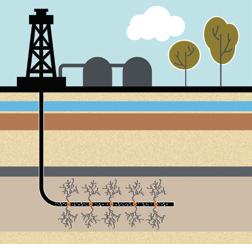
6 minute read
Oil and Gas Has Been Hit Hard
Oil and Gas Has Been Hit Hard by COVID-19, But Consider All Your Options Before Layoffs
By: Annette Idalski and Brian Smith
Advertisement
With the onset of COVID-19 and the resulting generaleconomic shutdown that is affecting much of the country, it is a challenging time to stay in business. But, the oil and gas industry has been hit particularly hard. In order to survive, oil and gas employers must develop a strategic plan to cut costs while maximizing flexibility with their workforce. Furloughs can best help achieve this goal. Layoffs are another option, but they are not the best choice if the oil and gas company intends to take advantage of certain government-loan programs offering forgiveness, such as the Paycheck Protection Program (PPP).
Administering Effective Furloughs
The term “furlough” is generally defined as a temporary leave of absence from employment duties without pay (although a small stipend or bonus may be paid) typically caused by exigent circumstances, such as a lack of funds or work. The benefits of a furlough, as opposed to a layoff, for employees include continued employment and maintenance of benefit eligibility subject to the terms of the employer’s benefit plans. Employers benefit because they can maintain their workforce without pay during periods when rigs are laid down and the industry is slow.
But, oil and gas employers should be careful not to make mistakes when embarking on a furlough. For example, not all employees should be treated the same. There are different requirements for employees classified as exempt and those classified as non-exempt under the Fair Labor Standards Act (FLSA).
For example, employers can furlough nonexempt employees by reducing hours, days or weeks worked without violating the FLSA. However, non-exempt employees must be paid for all time they spend working, including any work-related communications like monitoring or responding to emails or voicemails and com
pleting paperwork. Failure to do so could result in violations of the FLSA and cause an employer to suffer penalties such as paying the employee two times their hourly rate.
While exempt employees can be furloughed, the rules are not the same. Under the FLSA and most state-wage laws, an exempt employee is entitled to his or her same weekly salary for any workweek in which they perform any work, regardless of the number of hours worked. In other words, employers may not reduce an employee’s salary based on a reduced workweek schedule. There are some exceptions to this general rule. For instance, employers are not required to pay an exempt employee for any week in which no work is performed. Thus, a furlough for an exempt employee may consist of an arrangement where the employee works one week on and one week off, or two weeks on and two weeks off. While an employee is due their predetermined salary during weeks in which they are “on”, their salary is not due for weeks in which no work is performed. With this principle in mind, employers should clearly communicate to employees that they cannot work at all during the workweek in which they are off. If this occurs, even without the employer’s consent, the employee must be paid for the entire week to avoid risk of losing the employee’s exempt status.
An employer must keep in mind issues regarding unemployment benefits when considering furloughing employees.
In Texas, an employer may take advantage of the Mass Claims program which streamlines the unemployment-benefit claims process for employers and employees. As part of the program, employers can submit basic worker information on behalf of their employees to initiate claims for unemployment benefits. Other states, such as Georgia, require an employer to file for partial or full unemployment benefits on behalf of a furloughed employee. In Georgia, employers must file partial unemployment insurance claims on behalf of their eligible employees whenever it is necessary to temporarily reduce work hours or when there is no work available for a short period. Any employer found to be in violation of this rule will be required to reimburse the Georgia Department of Labor for the full amount of unemploymentinsurance benefits paid to the employee.
The Other Option - Layoffs
A layoff is the termination of employment, either temporary or permanent, at the employer’s instigation typically caused by exigent circumstances. These circumstances can include a lack of funds or work, or in this case, the COVID-19 pandemic. Laid-off employees are not paid, and unlike furloughed employees, they no longer remain employed, and they typically lose eligibility under employer benefit plans.
The most pressing issue an employer must consider when determining whether layoffs are appropriate is the consequence that follows, such as regarding forgiveness of any loan received under the Paycheck Protection Program, Section 1102 of the Coronavirus Aide, Relief, and Economic Stimulus Act. Under the PPP, a loan is forgivable in its entirety if 75% of the loan is used on payroll/benefit expenses. No more than 25% of the loan can be used for non-payroll/benefit expenses, and companies are limited in the types of expenses it can go toward, like rent and utilities.
Further, if an oil and gas company conducts layoffs, some or all of the loan may not be forgiven. For example, a certain amount of Full-Time Equivalent Employees (FTE) must be maintained. Unfortunately, FTE is not defined in the CARES Act or any applicable regulation, although guidance is expected in the near future. A good rule of thumb, until proper guidance comes along, is to deem FTEs to be the average number of employees over a given period who work at least 40 hours per week.
When determining whether forgiveness may be lost, an employer must determine the number of FTEs during the eight weeks after origination of the loan. An employer then divides this number by the number of FTEs during one of two baseline periods. These periods are (a) February 15, 2019 – June 30, 2019 or (b) January 1, 2020 – February 29, 2020. The employer is allowed to choose the period which is most beneficial (the period in which they had the lowest number of FTEs). Loan forgiveness is reduced proportionately according to what percent fewer FTEs an employer has during the eight week period than the baseline period.
It is important to note that there is a “fix” for layoff-related reduction in loan forgiveness. If by June 30, 2020, an employer raises its number of FTEs back to where they were on February 15, 2020, then that excuses whatever reduction in forgiveness was attributable to a drop in headcount between February 15, 2020 and April 26, 2020. As with much of the PPP, there is scant guidance on how to implement this saving provision. Accordingly, it is critical to consult with knowledgeable professionals in this area prior to taking any action.
Conclusion
While there are advantages and disadvantages to both furloughs and layoffs with respect to a decision for strategically cutting costs, any employer who has, or will be, receiving a loan under the PPP must give careful consideration to a decision to conduct layoffs. This is particularly important given the lack of guidance from the government regarding implementation of the PPP.
About the author: Annette A. Idalski is the National Chair of Chamberlain Hrdlicka’s Labor & Employment Group. She represents employers in the oilfield throughout the United States. She may be reached at annette.idalski@ chamberlainlaw.com.
About the author: Brian A. Smith is a senior associate at Chamberlain Hrdlicka, representing oil and gas companies. He may be reached at brian.smith@chamberlainlaw.com.










